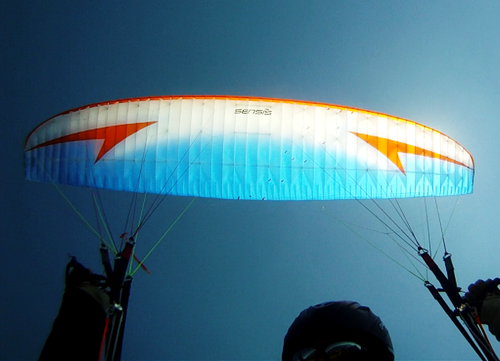Swing Sensis M |
|||||||||||||||||||||||||||||||||||||||||||||||||||||||||||||||||||||||||||||||||||||||||||||||||||||||||||||||||||||||||||||||||||||||||||||||||


|
|||||||||||||||||||||||||||||||||||||||||||||||||||||||||||||||||||||||||||||||||||||||||||||||||||||||||||||||||||||||||||||||||||||||||||||||||
Instability rating |
|||||||||||||||||||||||||||||||||||||||||||||||||||||||||||||||||||||||||||||||||||||||||||||||||||||||||||||||||||||||||||||||||||||||||||||||||
|
|||||||||||||||||||||||||||||||||||||||||||||||||||||||||||||||||||||||||||||||||||||||||||||||||||||||||||||||||||||||||||||||||||||||||||||||||
Glider characteristics |
|||||||||||||||||||||||||||||||||||||||||||||||||||||||||||||||||||||||||||||||||||||||||||||||||||||||||||||||||||||||||||||||||||||||||||||||||
|
Launch preparations: easy
launch characteristics: balanced, climbs constantly, no guidance necessary, good feedback during inflation, little braking required, slows before zenith, control check simple, low takeoff speed
asymmetric collapse: canopy colllapses at high angle to leading edge, high dynamics, total course change 270-360°, (4), fast course change rate, high forward pitching 75-90°, (5), very high height loss 50-59 m, (4), moderate sink velocity 15-19 m/s, (2), collapse on opposite wingtip with course change >90°, (5), with cravat, (5), G-Force 3,0- 3,4 G, (3)
Frontal collapse: canopy collapses with high total collapse aera, moderate pitch backwards 30-45°, marked pitch forwards 45-60°, moderate dynamics, no course change, (1), variable recovery behaviour, at times with stable closed frontal collapse, at times with automatic recovery, (4), usually symmetric recovery, simple pilot action required, (4), delayed return to normal airspeed, delayed reinflation of wingtips, with tendency to cravat, (4), high height loss 40-49 m, (3), low sink velocity 10-14 m/s, (1)
Spiral dives: moderate sink velocity increase, High G-Force 4,0-4,5 G, (3), Sink velocity after 720° <18 m/s, (3), High maximum sink velocity < 22 m/s, (3), sink velocity increase < 6 m/s on brake release, (2), Stable spiral dive, (5), Very high height loss during recovery >100 m, (4)
B-Stall: normal force required, moderate pitch backwards 15-30°, low pitch forwards <15°, stable sink phase, no tendency to deform, immediate return to normal airspeed, 6-8 m/s, height loss on recovery < 20 m
big ears: simple initiation, stable flight phase, delayed automatic recovery, Vsink unaccelerated 2,5-3 m/s, Vsink accelerated 3-3,5 m/s, Vunaccelerated 3-5 km/h less than trimspeed, Vaccelerated 3-5 km/h faster than trimspeed
Steering behaviour: dampened to balanced, 75 cm brake travel range, Noticable brake pressure increase, normal stall point, easily identifiable |
|||||||||||||||||||||||||||||||||||||||||||||||||||||||||||||||||||||||||||||||||||||||||||||||||||||||||||||||||||||||||||||||||||||||||||||||||
Notes |
|||||||||||||||||||||||||||||||||||||||||||||||||||||||||||||||||||||||||||||||||||||||||||||||||||||||||||||||||||||||||||||||||||||||||||||||||
|
TakeOff Glider is easy to prepare. Glider climbs by itself after the impuls of the pilot and slows down above him. Controlphase is easy. Air The glider feels very stable and damped. Thermals and turbulences were felt more through the risers than through the brakes. On the lower weightlimit, the glider feels slow and has a very damped handling. The glider should be flown with a good bodyweightshift for steering. The pilot should react sensitive on the brakepressurechange to pretend a stall in active air. Asymmetric Collapse The glider collapses always very surfacedeep without big efforts of the testpilot. Accelerated collapses generate a lot of dynamic. The testpilots had to react active against twists. Cravats, twists and collapses on the other side came up in the test. Front Collapse Symmetric collapses opened fast and without problems. Sometimes the wingtimes had to be openend by the pilot. Sometimes there was a tendency of cravats in the wingtips. Spiral Glider accelerated to the maximum sinkrate after brakerelease. The spiral is stable. Exit with a aktive brake input on the outside lead to an exit. B-Line-Stall Little bit nervous but all in all good behavior. BigEars Good behavoir. Wingtips have to be openend by the pilot. |
|||||||||||||||||||||||||||||||||||||||||||||||||||||||||||||||||||||||||||||||||||||||||||||||||||||||||||||||||||||||||||||||||||||||||||||||||
Rating |
|||||||||||||||||||||||||||||||||||||||||||||||||||||||||||||||||||||||||||||||||||||||||||||||||||||||||||||||||||||||||||||||||||||||||||||||||
|
Safety class 5 This class of paraglider reacts very demandingly to one or more of the following manoeuvres: frontal collapse, asymmetric collapse or spiral dive and may present pilots with a particular challenge.Very demandingly means that the above manoeuvres result in highly dynamic reactions from the glider, and/or large height losses. Critical subsequent glider reactions are also to be expected. Expert piloting skills achieved through constant practice, fast personal reaction times and precise pilot inputs are required to be able to immediately react to the above manoeuvres to maintain flight control and prevent large height loss or subsequent critical glider reactions. In particular, pilots should be able to recognise the onset of the above manoeuvres and be able to prevent or minimise their effects through immediate and precise pilot inputs. |
|||||||||||||||||||||||||||||||||||||||||||||||||||||||||||||||||||||||||||||||||||||||||||||||||||||||||||||||||||||||||||||||||||||||||||||||||

